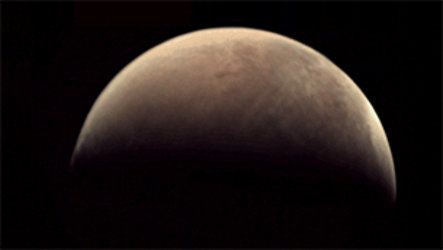Ice-coated beauty in Mars’ Silver Island
On 8 June, the high-resolution stereo camera on Mars Express captured a region within the 1800 km-wide and 5 km-deep Argyre basin, which was created by a gigantic impact in the planet’s early history.
After Hellas, the Argyre impact basin is the second largest on the Red Planet.

The name stems from the Greek word ‘argyros’ (silver) and Argyre was an ‘island of silver’ in Greek and Roman mythology. Giovanni Schiaparelli, the famed Italian astronomer, gave the name to this bright region on Mars in his detailed 1877 map.
At the centre of the larger impact basin is a flat region known as Argyre Planitia. The Mars Express images in this release all show a portion of the northern part of this plain, with a large portion of each image dominated by the western half of the 138 km-wide Hooke Crater, named after the British physicist and astronomer Robert Hooke.

Most of Argyre Planitia has been shaped by wind, glacial and lacustrine (lake-based) processes, creating the smoother appearance of the landscape surrounding Hooke Crater.
Inside Hooke Crater itself, prevailing wind activity has formed dunes and helped to create linear erosion features, clearly seen in the following topographic image.

The most striking feature of this image release, shown clearly in the first image at the top of the page, is the icing sugar-like covering of the surface to the south (left) of the image. This is frost, but made of carbon dioxide, not water.
Carbon dioxide ice is commonly seen on the surface of Mars, and has long been thought to form only at ground level, freezing out of the atmosphere as frost, which is most likely the case here.

The lowlands to the south (left in the first image) of Hooke and regions within the crater are covered by a thin ice layer. However, it is lacking on the inner north-facing crater wall. It was probably melted there by the Sun, as indicated by the timing of the image.
Taken at around 4:30 in the local afternoon and during the southern hemisphere’s mid-winter, the Sun would have been just over 20 degrees above the horizon. It should then have been able to melt ice on the steeper north-facing slopes, but would probably not have had enough time to warm and melt any on low-lying horizontal surfaces.
Schiaparelli would doubtless have marvelled at the exquisite images coming back from Mars Express, which continues to provide today’s scientists with a bounty of wonderful data.















 Germany
Germany
 Austria
Austria
 Belgium
Belgium
 Denmark
Denmark
 Spain
Spain
 Estonia
Estonia
 Finland
Finland
 France
France
 Greece
Greece
 Hungary
Hungary
 Ireland
Ireland
 Italy
Italy
 Luxembourg
Luxembourg
 Norway
Norway
 The Netherlands
The Netherlands
 Poland
Poland
 Portugal
Portugal
 Czechia
Czechia
 Romania
Romania
 United Kingdom
United Kingdom
 Slovenia
Slovenia
 Sweden
Sweden
 Switzerland
Switzerland

















































